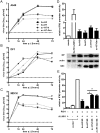The novel human influenza A(H7N9) virus is naturally adapted to efficient growth in human lung tissue
- PMID: 24105764
- PMCID: PMC3791893
- DOI: 10.1128/mBio.00601-13
The novel human influenza A(H7N9) virus is naturally adapted to efficient growth in human lung tissue
Erratum in
- MBio. 2014;5(4):doi:10.1128/mBio.01555-14
Abstract
A novel influenza A virus (IAV) of the H7N9 subtype has been isolated from severely diseased patients with pneumonia and acute respiratory distress syndrome and, apparently, from healthy poultry in March 2013 in Eastern China. We evaluated replication, tropism, and cytokine induction of the A/Anhui/1/2013 (H7N9) virus isolated from a fatal human infection and two low-pathogenic avian H7 subtype viruses in a human lung organ culture system mimicking infection of the lower respiratory tract. The A(H7N9) patient isolate replicated similarly well as a seasonal IAV in explanted human lung tissue, whereas avian H7 subtype viruses propagated poorly. Interestingly, the avian H7 strains provoked a strong antiviral type I interferon (IFN-I) response, whereas the A(H7N9) virus induced only low IFN levels. Nevertheless, all viruses analyzed were detected predominantly in type II pneumocytes, indicating that the A(H7N9) virus does not differ in its cellular tropism from other avian or human influenza viruses. Tissue culture-based studies suggested that the low induction of the IFN-β promoter correlated with an efficient suppression by the viral NS1 protein. These findings demonstrate that the zoonotic A(H7N9) virus is unusually well adapted to efficient propagation in human alveolar tissue, which most likely contributes to the severity of lower respiratory tract disease seen in many patients.
Importance: Humans are usually not infected by avian influenza A viruses (IAV), but this large group of viruses contributes to the emergence of human pandemic strains. Transmission of virulent avian IAV to humans is therefore an alarming event that requires assessment of the biology as well as pathogenic and pandemic potentials of the viruses in clinically relevant models. Here, we demonstrate that an early virus isolate from the recent A(H7N9) outbreak in Eastern China replicated as efficiently as human-adapted IAV in explanted human lung tissue, whereas avian H7 subtype viruses were unable to propagate. Robust replication of the H7N9 strain correlated with a low induction of antiviral beta interferon (IFN-β), and cell-based studies indicated that this is due to efficient suppression of the IFN response by the viral NS1 protein. Thus, explanted human lung tissue appears to be a useful experimental model to explore the determinants facilitating cross-species transmission of the H7N9 virus to humans.
Figures


References
-
- Gao HN, Lu HZ, Cao B, Du B, Shang H, Gan JH, Lu SH, Yang YD, Fang Q, Shen YZ, Xi XM, Gu Q, Zhou XM, Qu HP, Yan Z, Li FM, Zhao W, Gao ZC, Wang GF, Ruan LX, Wang WH, Ye J, Cao HF, Li XW, Zhang WH, Fang XC, He J, Liang WF, Xie J, Zeng M, Wu XZ, Li J, Xia Q, Jin ZC, Chen Q, Tang C, Zhang ZY, Hou BM, Feng ZX, Sheng JF, Zhong NS, Li LJ. 2013. Clinical findings in 111 cases of influenza A (H7N9) virus infection. N. Engl. J. Med. 368:2277–2285 - PubMed
-
- WHO 12 August 2013, posting date Number of confirmed human cases of avian influenza (H7N9) reported to WHO. World Health Organization, Geneva, Switzerland: http://www.who.int/influenza/human_animal_interface/influenza_h7n9/09_Re...
-
- Chen Y, Liang W, Yang S, Wu N, Gao H, Sheng J, Yao H, Wo J, Fang Q, Cui D, Li Y, Yao X, Zhang Y, Wu H, Zheng S, Diao H, Xia S, Zhang Y, Chan KH, Tsoi HW, Teng JL, Song W, Wang P, Lau SY, Zheng M, Chan JF, To KK, Chen H, Li L, Yuen KY. 2013. Human infections with the emerging avian influenza A H7N9 virus from wet market poultry: clinical analysis and characterisation of viral genome. Lancet 381:1916–1925 - PMC - PubMed
-
- Gao R, Cao B, Hu Y, Feng Z, Wang D, Hu W, Chen J, Jie Z, Qiu H, Xu K, Xu X, Lu H, Zhu W, Gao Z, Xiang N, Shen Y, He Z, Gu Y, Zhang Z, Yang Y, Zhao X, Zhou L, Li X, Zou S, Zhang Y, Li X, Yang L, Guo J, Dong J, Li Q, Dong L, Zhu Y, Bai T, Wang S, Hao P, Yang W, Zhang Y, Han J, Yu H, Li D, Gao GF, Wu G, Wang Y, Yuan Z, Shu Y. 2013. Human infection with a novel avian-origin influenza A (H7N9) virus. N. Engl. J. Med. 368:1888–1897 - PubMed
-
- Liu D, Shi W, Shi Y, Wang D, Xiao H, Li W, Bi Y, Wu Y, Li X, Yan J, Liu W, Zhao G, Yang W, Wang Y, Ma J, Shu Y, Lei F, Gao GF. 2013. Origin and diversity of novel avian influenza A H7N9 viruses causing human infection: phylogenetic, structural, and coalescent analyses. Lancet 381:1926–1932 - PubMed
Publication types
MeSH terms
Substances
Associated data
- Actions
- Actions
- Actions
- Actions
LinkOut - more resources
Full Text Sources
Other Literature Sources
Medical

